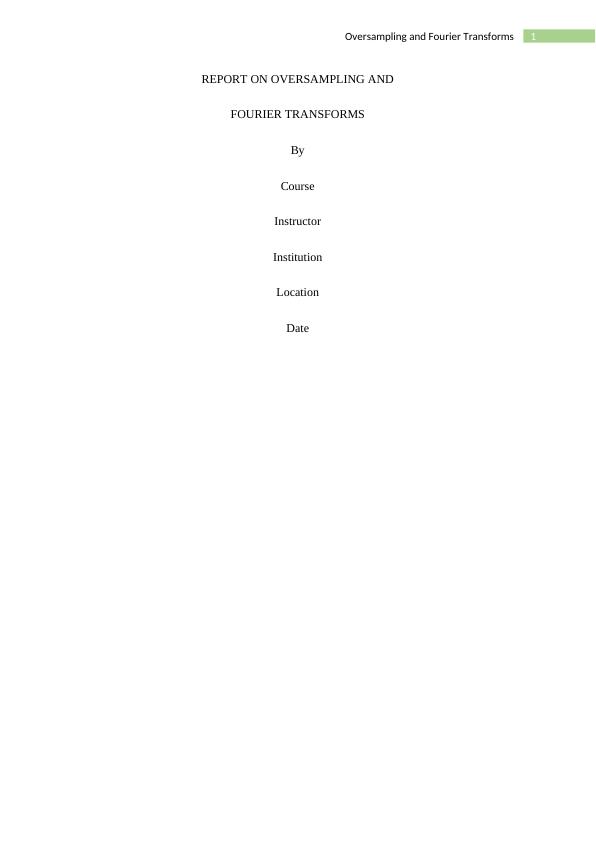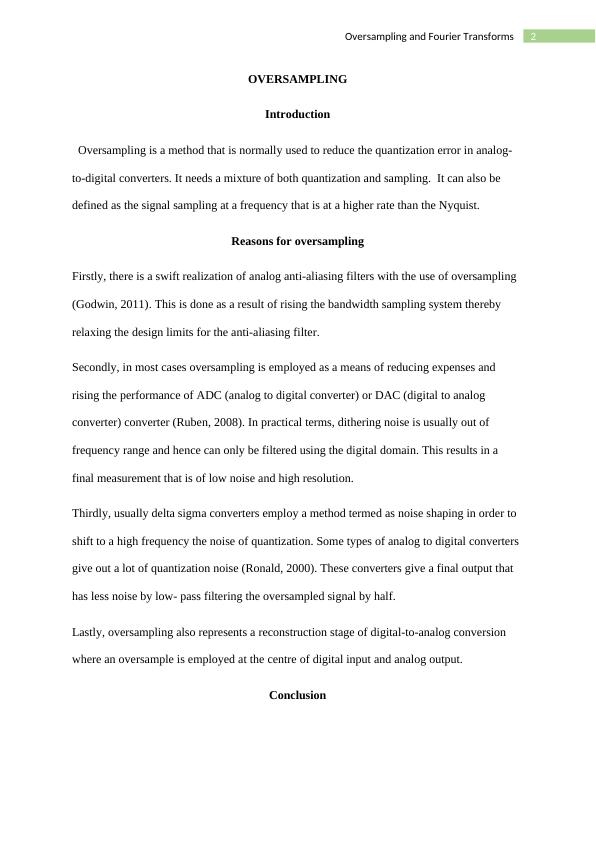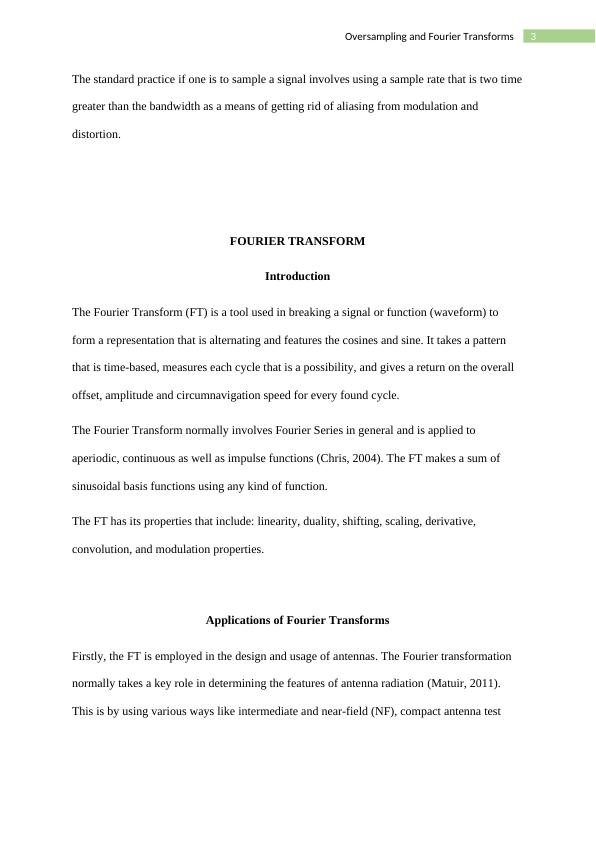Oversampling and Fourier Transforms
Added on 2023-05-28
6 Pages1152 Words353 Views
1Oversampling and Fourier Transforms
REPORT ON OVERSAMPLING AND
FOURIER TRANSFORMS
By
Course
Instructor
Institution
Location
Date
REPORT ON OVERSAMPLING AND
FOURIER TRANSFORMS
By
Course
Instructor
Institution
Location
Date

2Oversampling and Fourier Transforms
OVERSAMPLING
Introduction
Oversampling is a method that is normally used to reduce the quantization error in analog-
to-digital converters. It needs a mixture of both quantization and sampling. It can also be
defined as the signal sampling at a frequency that is at a higher rate than the Nyquist.
Reasons for oversampling
Firstly, there is a swift realization of analog anti-aliasing filters with the use of oversampling
(Godwin, 2011). This is done as a result of rising the bandwidth sampling system thereby
relaxing the design limits for the anti-aliasing filter.
Secondly, in most cases oversampling is employed as a means of reducing expenses and
rising the performance of ADC (analog to digital converter) or DAC (digital to analog
converter) converter (Ruben, 2008). In practical terms, dithering noise is usually out of
frequency range and hence can only be filtered using the digital domain. This results in a
final measurement that is of low noise and high resolution.
Thirdly, usually delta sigma converters employ a method termed as noise shaping in order to
shift to a high frequency the noise of quantization. Some types of analog to digital converters
give out a lot of quantization noise (Ronald, 2000). These converters give a final output that
has less noise by low- pass filtering the oversampled signal by half.
Lastly, oversampling also represents a reconstruction stage of digital-to-analog conversion
where an oversample is employed at the centre of digital input and analog output.
Conclusion
OVERSAMPLING
Introduction
Oversampling is a method that is normally used to reduce the quantization error in analog-
to-digital converters. It needs a mixture of both quantization and sampling. It can also be
defined as the signal sampling at a frequency that is at a higher rate than the Nyquist.
Reasons for oversampling
Firstly, there is a swift realization of analog anti-aliasing filters with the use of oversampling
(Godwin, 2011). This is done as a result of rising the bandwidth sampling system thereby
relaxing the design limits for the anti-aliasing filter.
Secondly, in most cases oversampling is employed as a means of reducing expenses and
rising the performance of ADC (analog to digital converter) or DAC (digital to analog
converter) converter (Ruben, 2008). In practical terms, dithering noise is usually out of
frequency range and hence can only be filtered using the digital domain. This results in a
final measurement that is of low noise and high resolution.
Thirdly, usually delta sigma converters employ a method termed as noise shaping in order to
shift to a high frequency the noise of quantization. Some types of analog to digital converters
give out a lot of quantization noise (Ronald, 2000). These converters give a final output that
has less noise by low- pass filtering the oversampled signal by half.
Lastly, oversampling also represents a reconstruction stage of digital-to-analog conversion
where an oversample is employed at the centre of digital input and analog output.
Conclusion

3Oversampling and Fourier Transforms
The standard practice if one is to sample a signal involves using a sample rate that is two time
greater than the bandwidth as a means of getting rid of aliasing from modulation and
distortion.
FOURIER TRANSFORM
Introduction
The Fourier Transform (FT) is a tool used in breaking a signal or function (waveform) to
form a representation that is alternating and features the cosines and sine. It takes a pattern
that is time-based, measures each cycle that is a possibility, and gives a return on the overall
offset, amplitude and circumnavigation speed for every found cycle.
The Fourier Transform normally involves Fourier Series in general and is applied to
aperiodic, continuous as well as impulse functions (Chris, 2004). The FT makes a sum of
sinusoidal basis functions using any kind of function.
The FT has its properties that include: linearity, duality, shifting, scaling, derivative,
convolution, and modulation properties.
Applications of Fourier Transforms
Firstly, the FT is employed in the design and usage of antennas. The Fourier transformation
normally takes a key role in determining the features of antenna radiation (Matuir, 2011).
This is by using various ways like intermediate and near-field (NF), compact antenna test
The standard practice if one is to sample a signal involves using a sample rate that is two time
greater than the bandwidth as a means of getting rid of aliasing from modulation and
distortion.
FOURIER TRANSFORM
Introduction
The Fourier Transform (FT) is a tool used in breaking a signal or function (waveform) to
form a representation that is alternating and features the cosines and sine. It takes a pattern
that is time-based, measures each cycle that is a possibility, and gives a return on the overall
offset, amplitude and circumnavigation speed for every found cycle.
The Fourier Transform normally involves Fourier Series in general and is applied to
aperiodic, continuous as well as impulse functions (Chris, 2004). The FT makes a sum of
sinusoidal basis functions using any kind of function.
The FT has its properties that include: linearity, duality, shifting, scaling, derivative,
convolution, and modulation properties.
Applications of Fourier Transforms
Firstly, the FT is employed in the design and usage of antennas. The Fourier transformation
normally takes a key role in determining the features of antenna radiation (Matuir, 2011).
This is by using various ways like intermediate and near-field (NF), compact antenna test

End of preview
Want to access all the pages? Upload your documents or become a member.
Related Documents
Block Diagram of a DSP System PDFlg...
|5
|1063
|477
Compute Network And Security Analysislg...
|22
|3456
|9
Spectrum Analyzer Project - Analyzing Modulated Signals and Time Domain Measurementslg...
|6
|1228
|185
Designing FIR Filters for Signal Processinglg...
|18
|3101
|78
